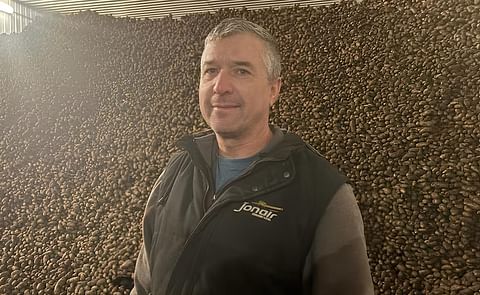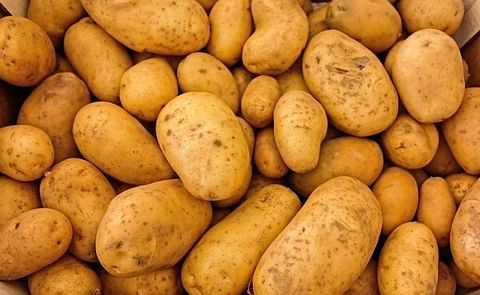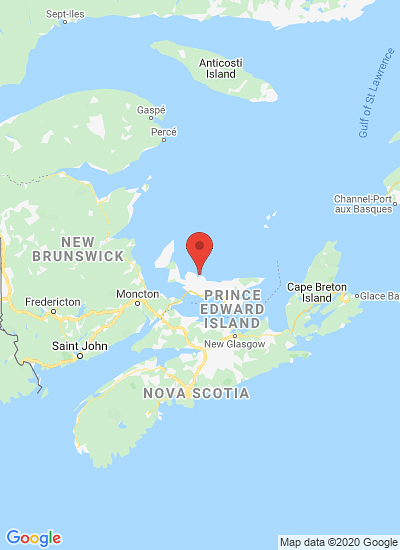McCain's one-year multi-species blend contains 13 species, including spring oats, balansa clover, Austrian winter peas and sunflower. (Courtesy: Bryce Drummond, McCain Fertilizer)
McCain trialing multi-species cover crop blend for rotation in the Canadian potato provinces
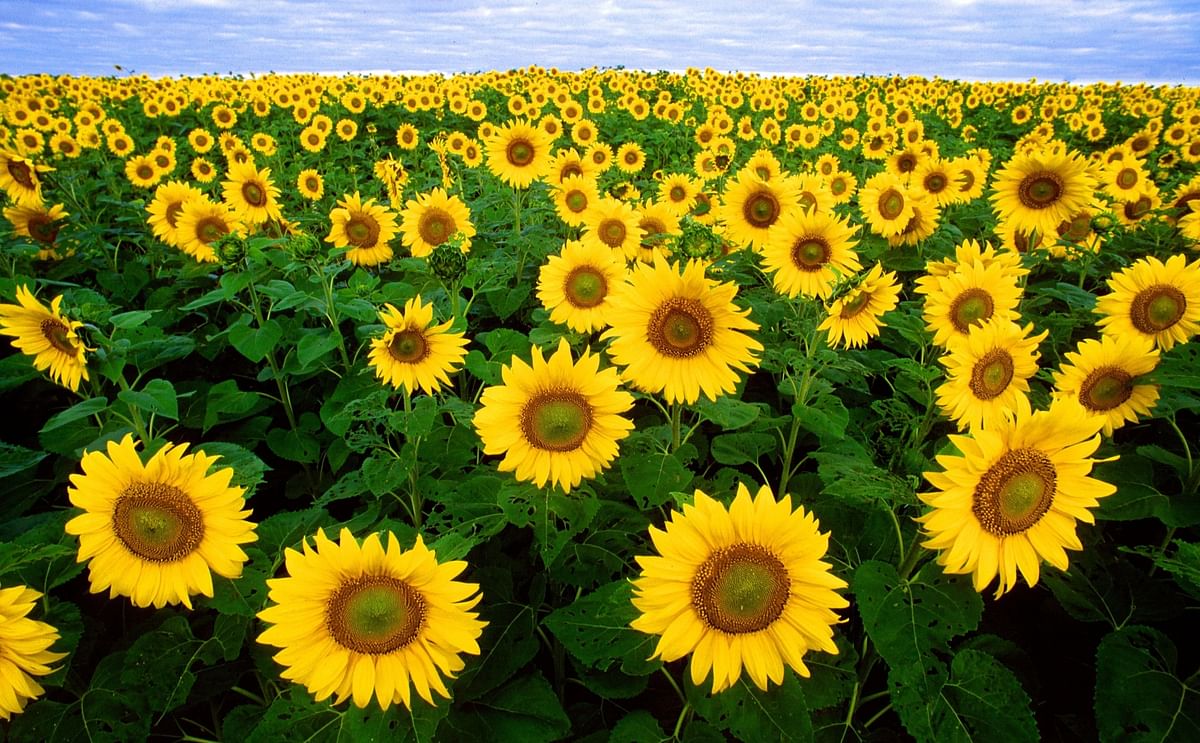
Soil organic matter has become a popular topic of discussion in the past year. In Ontario, a report from late 2016 indicated soil organic matter (SOM) levels in many parts of the province are at 15-year lows, coinciding with increasing interest in the use of cover crops, reduced- or no-till management and longer rotations in the past three to five years.
On Prince Edward Island (PEI), the issue of low soil organic matter levels is also a concern. During the 2018 International Potato Technology Expo this past February, soil health was one of the topics for presentation and discussions, as much of a concern among industry stakeholders as it is for growers.
Most growers are farming on 2.0 to 2.5 per cent soil organic matter, although some at the extreme end of the spectrum are under 1.0 per cent. It’s enough that retailers and seed companies are encouraging the use of cover crops to protect the red sandy soils on the Island. Some are also advising farmers to lengthen their rotations with corn, winter wheat or peas.
One of the surprising sights at the 2018 Potato Expo was at the McCain booth, where attendees could view a slide presentation on the company’s introduction of a multi-species cover crop blend, with a bag of the seed mix on display.
Bryce Drummond, territory manager with McCain Fertilizer, a division of McCain Produce, notes the soil organic matter issue has been developing for decades but that it’s become more serious in the past 10 to 15 years. Prior to 2003, P.E.I. had a healthy livestock sector with beef cattle and hogs. When bovine spongiform encephalopathy (BSE) hit Western Canada, it also affected the beef sector in the Maritimes and reduced the hog market in the region shortly thereafter.
When there was a livestock sector, the conventional rotation for potato growers was potatoes, a cereal and then hay or a forage crop. After BSE hit, there was little or no market for beef or for the cereals fed to cattle.
Bryce Drummond, territory manager with McCain Fertilizer:
“The price of cereals dropped off because there were no cattle to feed and growers were looking for a cash crop, and soybeans were the best option.”
“Now, a lot of potato farmers realize that soybeans do not fit well into the rotation and they’ve been more focused on the potato aspect, so they’re growing potatoes and a cover crop.”
In the past few years, McCain has come up with two blends, a one-year (annual) and a two-year. The one-year features 13 species, including pearl millet, sorghum Sudan grass, spring oats, dwarf Essex rape, Austrian winter peas, fababeans, chickling vetch, balansa clover, buckwheat, sunflower, phacelia, Winter Hawk ryegrass and Ethiopian cabbage.
The two-year blend has 12 species, with pearl millet, sorghum Sudan grass, spring oats, Austrian winter peas, fababeans, balansa clover and sunflower — all annuals. Those die off after the first year leaving a second-year crop of Winter Hawk ryegrass, perennial ryegrass, alfalfa, double-cut red clover and timothy.
In terms of timing for planting the cover crop blends, Drummond states that planting before June 15 (in most years) on the Island isn’t recommended. Grasses like pearl millet and sorghum Sudan require warmer temperatures in order to grow at their optimum, which then speeds biomass production and reduces compaction.
Considering there are very few different soil types on P.E.I. — it’s mainly a rust-coloured sandy loam that, of course, works well with potatoes — these two blends have been developed for those soils and with potatoes as the key crop. Alfalfa is used for its taproot to break through compacted layers and it’s a legume that provides added nitrogen. Sunflower produces root exudates which extract zinc from the soil and releases it the following season. Buckwheat grows with a fine root system, which is excellent for cycling soil phosphorus, a key fertilizer in potato production, and increases its availability in subsequent crops.
Drummond notes the company launched the one-year multi-species blend in 2017, following with the two-year mix this year. Company representatives visited various fields where they’d planted the one-year blend, just to see what did or didn’t work.
Bryce Drummond:
“This time next year, I’m sure the blend will be a little different.”
“Not one field looks the same, and depending on what the field is lacking or has in surplus nutrient-wise, every field we looked at last year is completely different.”
Weed management and fertility
The learning curve isn’t as steep as some might think. Cover crops aren’t exactly a new idea in the region. Several years ago, growers planted mustard as a cover, with the belief that it provided control of wireworm (a different species than that found in Ontario). However, Drummond points out that the multi-species blends developed by McCain are not hosts for anything. Instead, the blends are designed to help build SOM.
Still, there are some facets that are different in a beneficial way. Weed control in potatoes varies from conventional corn, wheat and soybean rotations, but Drummond notes that either of the multi-species blends provides effective weed management, primarily because little can penetrate the thick mat of the cover crop. As for fertilizing, there is not a hard-and-fast rule either.
Bryce Drummond
“What we recommend here is to wait for the crop to emerge, then broadcast about 30 lbs. of actual nitrogen, so you’re looking at about 100 lbs. of calcitic ammonium nitrate.”
“Some farmers choose not to use fertilizer and see good results.”
The reason may again have to with the inclusion of sunflower, buckwheat and peas. Sunflower ties up and releases nutrients the following season, buckwheat is a scavenger of surplus nutrients, and peas provide N to subsequent crops.
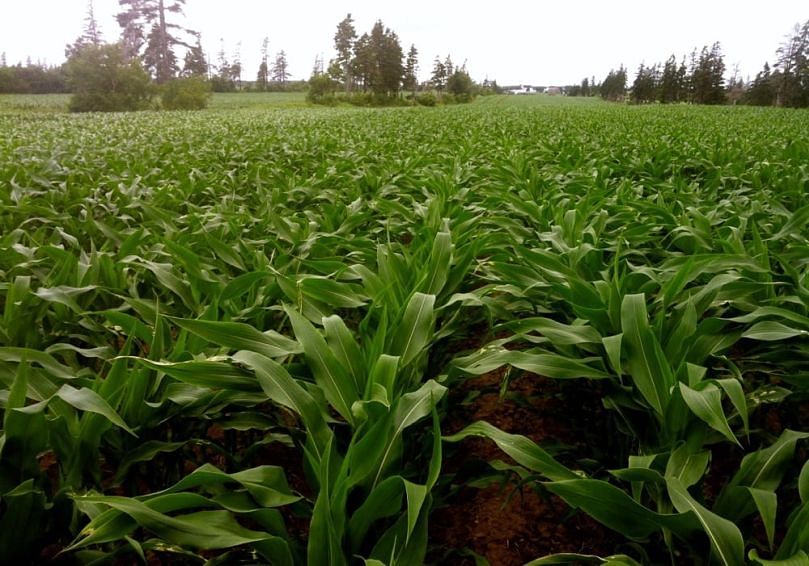
Corn production on the Island is challenged by the timing conflicts, with growers busy in potatoes when the corn needs attention.(Courtesy Andrew Van Wiechen, Phillips Agri Services)
Other cropping options
At the 2008 International Potato Technology Expo, Pioneer Hi-Bred (as it was known at the time), hosted a booth and was actively promoting corn, soybeans and winter wheat as rotational crops for potatoes.
Soybean was the favourite then, given its ease in planting (since many growers rotated cereals with their potatoes and would therefore have a seed drill). It was perceived to be easier to manage, and in the days when the Island’s hog sector was stable, producers could roast soybeans for feed, although most of the production was shipped by the local elevators.
By the early 2010s, there was anecdotal evidence of an increase in soybean production, purely as a rotational crop, but it quickly became evident that soybeans add little if anything to the soil in terms of residue, and they consume relatively large amounts of potash.
At the 2018 Potato Expo, Andrew Van Wiechen was at the DuPont Pioneer booth, and it was corn that was discussed, largely because of its residue and the impact that might have on long-term soil organic matter.
It’s a slower climb for corn production on the Island. For starters, it’s not a large enough market to encourage specific hybrid development. But the investment for equipment is also relatively high and there are several weather-related effects that must be considered. In spite of its residue potential, there’s also the question of what does a grower do with a bin-full of corn?
It all comes down to one basic focus on P.E.I.: potatoes.
Andrew Van Wiechen, who works for Phillips Agri Services in Charlottetown:
“You have to understand their workload, where they’re digging potatoes in October and it’s a fairly stressful job, it requires a lot of detail because it’s a perishable crop.”
“After that’s done, trying to tackle a corn harvest is not very appealing to a lot of people. But more of what we see is the corn grower who will be set up with the dryer and the combine and the planter who will grow that crop.”
The dryer is vital for corn production on the Island. Although P.E.I. enjoys a moderate climate, its summer evenings are relatively cool, forcing the crop to “ramp back up” the following day. Coupled with later frosts in the fall, it means the crop will reach black layer and mature, but usually at moisture levels as high as 30 per cent. That’s something that Van Wiechen says growers must accept in order to grow corn on P.E.I.
Andrew Van Wiechen, Phillips Agri Services
“It’s not a lot of fun trying to put that through a dryer, and that scares a lot of people.”
“This past fall was about as good as you’re going to get, and the corn was coming in at 25 per cent, and you can deal with that. But that’s maybe the stalling point.”
That only compounds the challenge of producing corn in the region. In the potato-growing section of New Brunswick (northwest of Fredericton — roughly between Woodstock and Grand Falls), the main threat to corn hybrids is early frost. In the Annapolis Valley of Nova Scotia, warmer temperatures provide ideal conditions for full-maturity hybrids.
West heading East
One trend that’s benefiting the Maritimes corn production is the breeding work conducted for Western Canada. Short-season hybrids in the works for the West also open up more opportunities for Maritime growers.
For end use, options for corn involve trucking to mills in Moncton or the Annapolis Valley. Ultimately, the cost of trucking is simply factored as part of the cost of growing the crop.
Andrew Van Wiechen:
“Some of our corn is a little lighter bushel weight, but that’s changing with these new hybrids because they’re maturing earlier and drying in the field, and getting better bushel weights.”
For corn, there’s the investment, the late-season management and learning more about the crop and its challenges and benefits — much like cover crops.
Regardless of the method, though, and whether it’s based on cover crops or corn, the battle to replenish soil organic matter levels won’t be over any time soon.
As everyone on the Island now knows, it all takes time.


